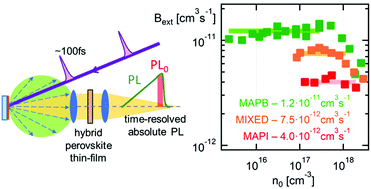Direct measurement of radiative decay rates in metal halide perovskites†
Abstract
The rate of light emission per unit carrier concentration, or radiative rate, is a fundamental semiconductor parameter that determines the limit photoconversion efficiency of solar cells. In hybrid perovskites, a champion materials class for photovoltaics, optical emission results from a bimolecular process, so that the radiative rate depends on the carrier density and cannot be directly measured with standard techniques. Instead, it is estimated either from UV-Vis absorption or from the kinetics of photoexcitation decays in time-resolved spectroscopy experiments. In this work, an ultrafast radiometric experiment is introduced to directly assess the radiative decay rate in perovskite thin films through a calibrated measurement of the instantaneous photoluminescence flux under pulsed laser excitation. The measured radiative decay rate is found to be significantly lower than the second order decay constant determined from photoluminescence decay kinetics, contrary to what is often assumed; it is also 50–100 times slower than estimates for a plasma of free excitons and free charged carriers, obtained from absorption coefficients through optical reciprocity relations. We attribute the microscopic origin of the measured low radiative rate to the formation of a population of dark excitations, specifically large polarons. Our results provide a coherent framework to rationalize radiative and non-radiative carrier recombination processes in metal halide perovskites, as well as the photophysical basis to optimize device performances for this emerging class of semiconductors.



 Please wait while we load your content...
Please wait while we load your content...